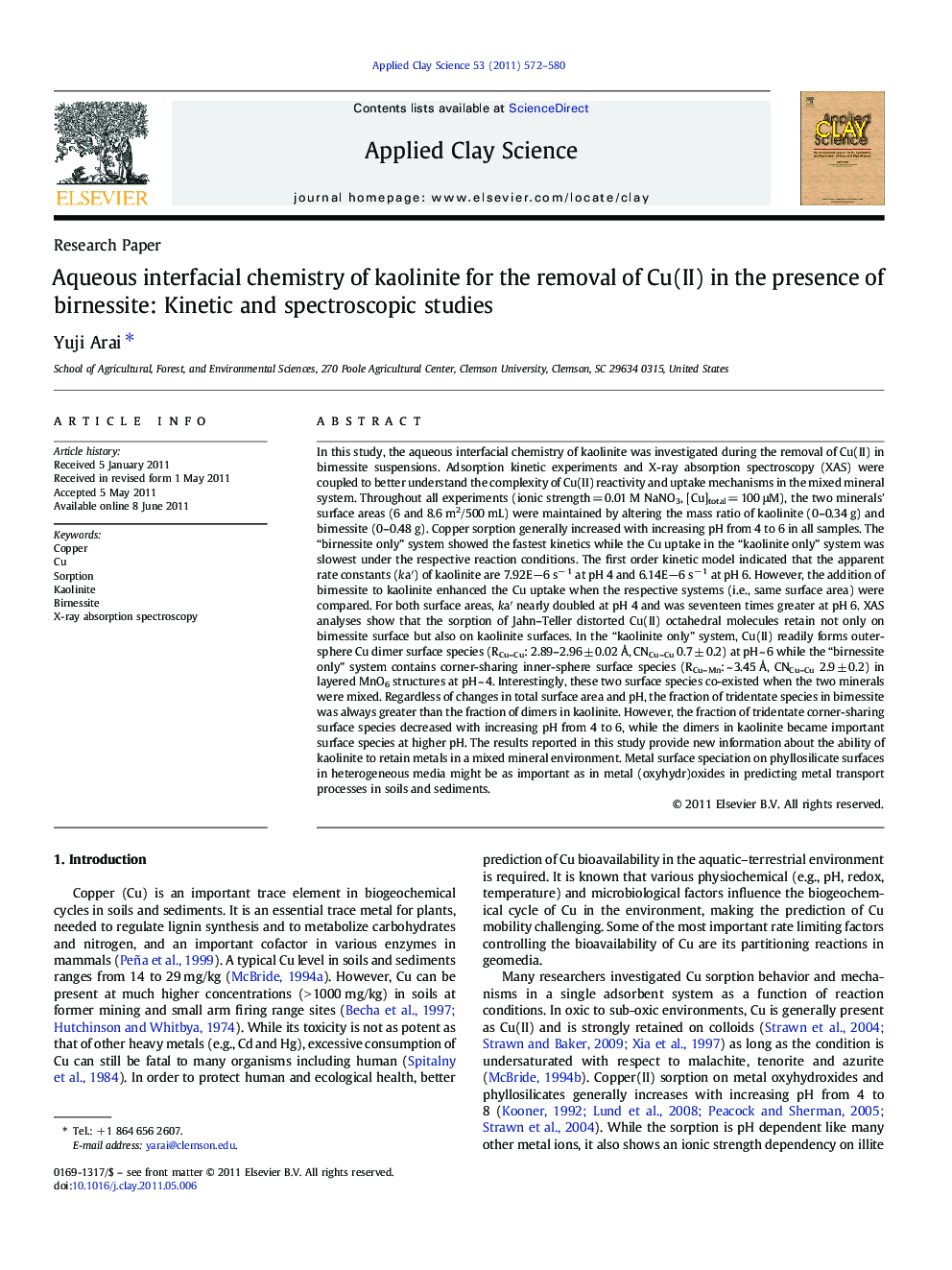| کد مقاله | کد نشریه | سال انتشار | مقاله انگلیسی | نسخه تمام متن |
|---|---|---|---|---|
| 1695412 | 1011859 | 2011 | 9 صفحه PDF | دانلود رایگان |

In this study, the aqueous interfacial chemistry of kaolinite was investigated during the removal of Cu(II) in birnessite suspensions. Adsorption kinetic experiments and X-ray absorption spectroscopy (XAS) were coupled to better understand the complexity of Cu(II) reactivity and uptake mechanisms in the mixed mineral system. Throughout all experiments (ionic strength = 0.01 M NaNO3, [Cu]total = 100 μM), the two minerals' surface areas (6 and 8.6 m2/500 mL) were maintained by altering the mass ratio of kaolinite (0–0.34 g) and birnessite (0–0.48 g). Copper sorption generally increased with increasing pH from 4 to 6 in all samples. The “birnessite only” system showed the fastest kinetics while the Cu uptake in the “kaolinite only” system was slowest under the respective reaction conditions. The first order kinetic model indicated that the apparent rate constants (ka′) of kaolinite are 7.92E−6 s− 1 at pH 4 and 6.14E−6 s− 1 at pH 6. However, the addition of birnessite to kaolinite enhanced the Cu uptake when the respective systems (i.e., same surface area) were compared. For both surface areas, ka′ nearly doubled at pH 4 and was seventeen times greater at pH 6. XAS analyses show that the sorption of Jahn–Teller distorted Cu(II) octahedral molecules retain not only on birnessite surface but also on kaolinite surfaces. In the “kaolinite only” system, Cu(II) readily forms outer-sphere Cu dimer surface species (RCu–Cu: 2.89–2.96 ± 0.02 Å, CNCu–Cu 0.7 ± 0.2) at pH ~ 6 while the “birnessite only” system contains corner-sharing inner-sphere surface species (RCu–Mn: ~ 3.45 Å, CNCu–Cu 2.9 ± 0.2) in layered MnO6 structures at pH ~ 4. Interestingly, these two surface species co-existed when the two minerals were mixed. Regardless of changes in total surface area and pH, the fraction of tridentate species in birnessite was always greater than the fraction of dimers in kaolinite. However, the fraction of tridentate corner-sharing surface species decreased with increasing pH from 4 to 6, while the dimers in kaolinite became important surface species at higher pH. The results reported in this study provide new information about the ability of kaolinite to retain metals in a mixed mineral environment. Metal surface speciation on phyllosilicate surfaces in heterogeneous media might be as important as in metal (oxyhydr)oxides in predicting metal transport processes in soils and sediments.
► Surface chemistry of kaolinite controls the metal retention in heterogeneous geomedia.
► Kaolinite contributes to the retention of Cu in the kaolinite–birnessite system.
► Copper surface speciation in the mixed kaolinite–birnessite system is affected by pH.
► Dimer-like Cu surface specie form at the kaolinite–water interface.
Journal: Applied Clay Science - Volume 53, Issue 4, October 2011, Pages 572–580